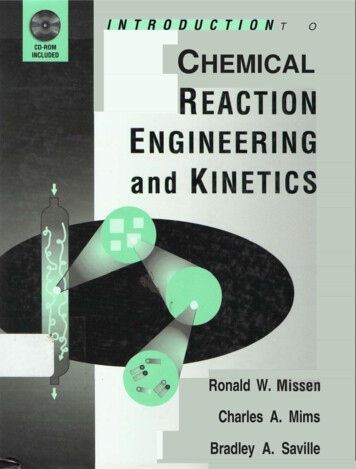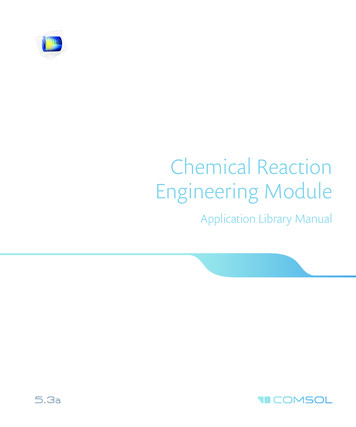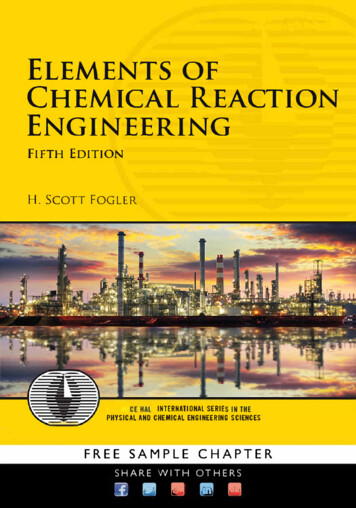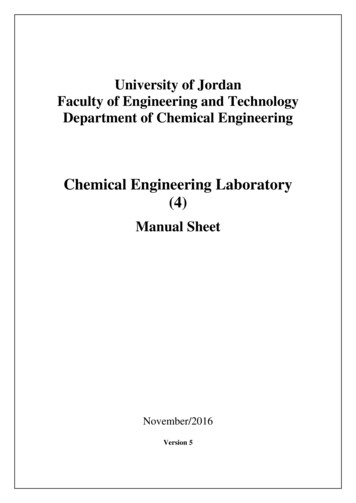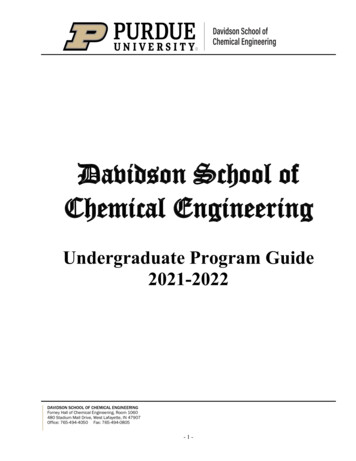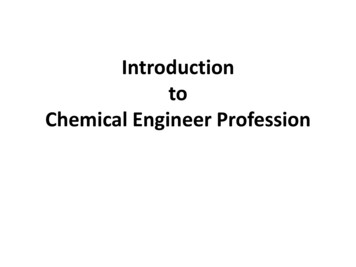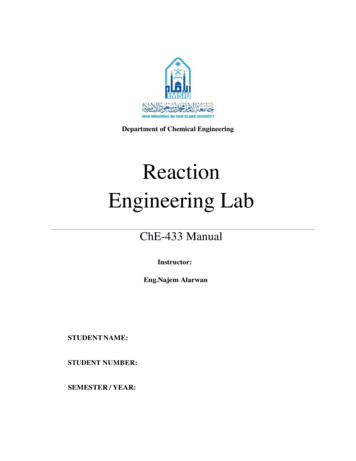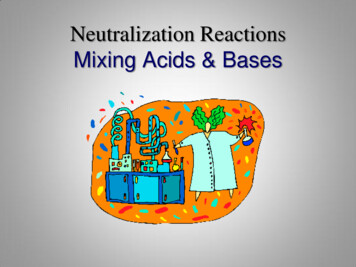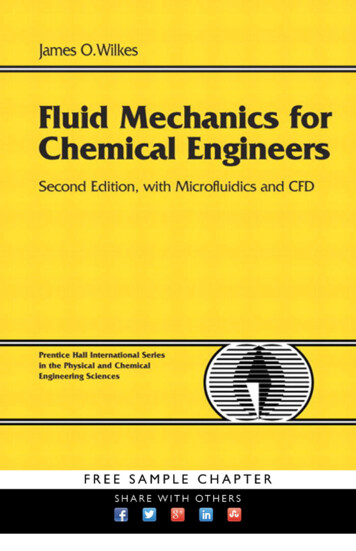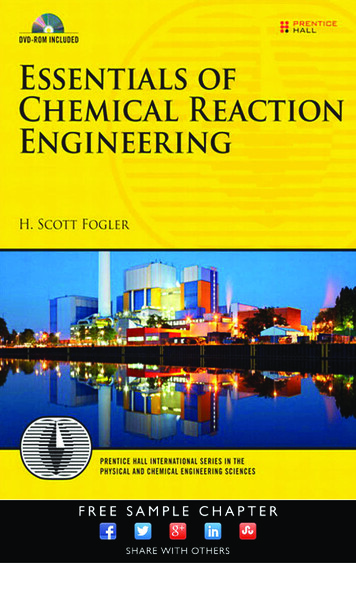
Transcription
Essentialsof ChemicalReactionEngineering
Prentice Hall International Series in thePhysical and Chemical Engineering SciencesVisit informit.com /ph /physandchemfor a complete list of available publications.The Prentice Hall International Series in the Physical andChemical Engineering Sciences had its auspicious beginning in1956 under the direction of Neal R. Amundsen. The series comprises themost widely adopted college textbooks and supplements for chemicalengineering education. Books in this series are written by the foremosteducators and researchers in the field of chemical engineering.
Essentialsof ChemicalReactionEngineeringH. SCOTT FOGLERAme and Catherine Vennema Professor of Chemical Engineeringand the Arthur F. Thurnau ProfessorThe University of Michigan, Ann ArborUpper Saddle River, NJ Boston Indianapolis San FranciscoNew York Toronto Montreal London Munich Paris MadridCapetown Sydney Tokyo Singapore Mexico City
Many of the designations used by manufacturers and sellers to distinguish their products are claimed astrademarks. Where those designations appear in this book, and the publisher was aware of a trademark claim,the designations have been printed with initial capital letters or in all capitals.The author and publisher have taken care in the preparation of this book, but make no expressed or impliedwarranty of any kind and assume no responsibility for errors or omissions. No liability is assumed for incidental or consequential damages in connection with or arising out of the use of the information or programscontained herein.The publisher offers excellent discounts on this book when ordered in quantity for bulk purchases or specialsales, which may include electronic versions and/or custom covers and content particular to your business,training goals, marketing focus, and branding interests. For more information, please contact:U.S. Corporate and Government Sales(800) 382-3419corpsales@pearsontechgroup.comFor sales outside the United States, please contact:International Salesinternational@pearson.comVisit us on the Web: informit.com/phLibrary of Congress Cataloging-in-Publication DataFogler, H. Scott.Essentials of chemical reaction engineering / H. Scott Fogler.p. cm.Includes index.ISBN 978-0-13-714612-3 (hardcover : alk. paper)1. Chemical reactors—Design and construction. 2. Chemical reactors.I. Title.TP157.F654 2011660'.2832—dc222010022352Copyright 2011 Pearson Education, Inc.All rights reserved. Printed in the United States of America. This publication is protected by copyright, andpermission must be obtained from the publisher prior to any prohibited reproduction, storage in a retrievalsystem, or transmission in any form or by any means, electronic, mechanical, photocopying, recording, orlikewise. To obtain permission to use material from this work, please submit a written request to PearsonEducation, Inc., Permissions Department, One Lake Street, Upper Saddle River, New Jersey 07458, or youmay fax your request to (201) 236-3290.ISBN-13: 978-0-13-714612-3ISBN-10:0-13-714612-4Text printed in the United States on recycled paper at Courier in Westford, Massachusetts.Third printing, February 2014
Dedicated toJanet Meadors FoglerFor her companionship, encouragement, sense of humor,and support throughout the years.
This page intentionally left blank
ContentsPREFACExvABOUT THE AUTHORCHAPTER 11.11.21.31.41.5CHAPTER 22.12.22.32.42.5xxixMOLE BALANCES1The Rate of Reaction, –rA4The General Mole Balance Equation8Batch Reactors (BRs)10Continuous-Flow Reactors121.4.1Continuous-Stirred Tank Reactor (CSTR)1.4.2Tubular Reactor141.4.3Packed-Bed Reactor (PBR)18Industrial Reactors2212CONVERSION AND REACTOR SIZINGDefinition of Conversion34Batch Reactor Design Equations34Design Equations for Flow Reactors372.3.1CSTR (Also Known as a Backmix Reactor or a Vat)2.3.2Tubular Flow Reactor (PFR)382.3.3Packed-Bed Reactor (PBR)39Sizing Continuous-Flow Reactors40Reactors in Series492.5.1CSTRs in Series502.5.2PFRs in Series54vii3338
viiiContents2.5.32.5.42.6CHAPTER 33.13.23.33.4CHAPTER 44.14.2CHAPTER 55.15.25.35.45.55.6Combinations of CSTRs and PFRs in Series55Comparing the CSTR and PFR Reactor Volumes and ReactorSequencing59Some Further Definitions602.6.1Space Time602.6.2Space Velocity62RATE LAWS73Basic Definitions743.1.1Relative Rates of Reaction74The Reaction Order and the Rate Law763.2.1Power Law Models and Elementary Rate Laws763.2.2Nonelementary Rate Laws803.2.3Reversible Reactions83The Reaction Rate Constant86Present Status of Our Approach to Reactor Sizing and Design93STOICHIOMETRYBatch Systems1074.1.1Equations for Batch Concentrations109Flow Systems1134.2.1Equations for Concentrations in Flow Systems4.2.2Liquid-Phase Concentrations1144.2.3Gas Phase Concentrations115105114ISOTHERMAL REACTOR DESIGN: CONVERSIONDesign Structure for Isothermal Reactors140Batch Reactors (BRs)1445.2.1Batch Reaction Times144Continuous Stirred Tank Reactors (CSTRs)1525.3.1A Single CSTR1525.3.2CSTRs in Series155Tubular Reactors162Pressure Drop in Reactors1695.5.1Pressure Drop and the Rate Law1695.5.2Flow Through a Packed Bed1705.5.3Pressure Drop in Pipes1745.5.4Analytical Solution for Reaction with Pressure DropSynthesizing the Design of a Chemical Plant188139177
ixContentsCHAPTER 66.16.26.36.46.56.6CHAPTER 77.17.27.37.47.57.67.7CHAPTER 88.18.28.38.48.5ISOTHERMAL REACTOR DESIGN: MOLAR FLOW RATES207The Molar Flow Rate Balance Algorithm208Mole Balances on CSTRs, PFRs, PBRs, and Batch Reactors2086.2.1Liquid Phase2086.2.2Gas Phase210Applications of the Molar Flow Rate Algorithm to Microreactors212Membrane Reactors217Unsteady-State Operation of Stirred Reactors225Semibatch Reactors2266.6.1Motivation for Using a Semibatch Reactor2266.6.2Semibatch Reactor Mole Balances227COLLECTION AND ANALYSIS OF RATE DATA245The Algorithm for Data Analysis246Determining the Reaction Order for Each of Two Reactants Using theMethod of Excess248Integral Method249Differential Method of Analysis2537.4.1Graphical Differentiation Method2547.4.2Finding the Rate Law Parameters254Nonlinear Regression259Reaction Rate Data from Differential Reactors264Experimental Planning271MULTIPLE REACTIONSDefinitions2838.1.1Types of thm for Multiple Reactions2868.2.1Modifications to the Chapter 6 CRE Algorithm for MultipleReactions288Parallel Reactions2898.3.1Selectivity2898.3.2Maximizing the Desired Product for One Reactant2898.3.3Reactor Selection and Operating Conditions295Reactions in Series298Complex Reactions3088.5.1Complex Reactions in a PBR3088.5.2Multiple Reactions in a CSTR311283
xContents8.68.78.8CHAPTER 9Membrane Reactors to Improve Selectivity in Multiple ReactionsSorting It All Out321The Fun Part321316REACTION MECHANISMS, PATHWAYS, BIOREACTIONS,AND BIOREACTORS9.19.29.39.4CHAPTER 1010.110.2339Active Intermediates and Nonelementary Rate Laws3409.1.1Pseudo-Steady-State Hypothesis (PSSH)3419.1.2Searching for a Mechanism3459.1.3Chain Reactions348Enzymatic Reaction Fundamentals3499.2.1Enzyme–Substrate n Equation3549.2.4Batch Reactor Calculations for Enzyme Reactions359Inhibition of Enzyme Reactions3649.3.1Competitive Inhibition3649.3.2Uncompetitive Inhibition3679.3.3Noncompetitive Inhibition (Mixed Inhibition)3689.3.4Substrate Inhibition370Bioreactors and Biosynthesis3719.4.1Cell Growth3759.4.2Rate Laws3769.4.3Stoichiometry3799.4.4Mass Balances3839.4.5Chemostats3879.4.6CSTR Bioreactor Operation3889.4.7Wash-Out389CATALYSIS AND CATALYTIC REACTORSCatalysts40910.1.1 Definitions41010.1.2 Catalyst Properties41110.1.3 Catalytic Gas-Solid Interactions41310.1.4 Classification of Catalysts414Steps in a Catalytic Reaction41510.2.1 Step 1 Overview: Diffusion from the Bulk to the ExternalSurface of the Catalyst41810.2.2 Step 2 Overview: Internal Diffusion41910.2.3 Adsorption Isotherms42010.2.4 Surface Reaction426409
xiContents10.310.410.510.6CHAPTER 1111.111.211.311.411.511.610.2.5 Desorption42810.2.6 The Rate-Limiting Step428Synthesizing a Rate Law, Mechanism, and Rate-Limiting Step43110.3.1 Is the Adsorption of Cumene Rate-Limiting?43410.3.2 Is the Surface Reaction Rate-Limiting?43710.3.3 Is the Desorption of Benzene Rate-Limiting?43910.3.4 Summary of the Cumene Decomposition44010.3.5 Reforming Catalysts44110.3.6 Rate Laws Derived from the Pseudo-Steady-StateHypothesis (PSSH)44510.3.7 Temperature Dependence of the Rate Law446Heterogeneous Data Analysis for Reactor Design44610.4.1 Deducing a Rate Law from the Experimental Data44810.4.2 Finding a Mechanism Consistent with ExperimentalObservations44910.4.3 Evaluation of the Rate Law Parameters45010.4.4 Reactor Design453Reaction Engineering in Microelectronic Fabrication45610.5.1 Overview45610.5.2 Chemical Vapor Deposition458Model Discrimination461NONISOTHERMAL REACTOR DESIGN–THE STEADYSTATE ENERGY BALANCE AND ADIABATIC PFRAPPLICATIONSRationale478The Energy Balance47911.2.1 First Law of Thermodynamics47911.2.2 Evaluating the Work Term48011.2.3 Overview of Energy Balances482The User Friendly Energy Balance Equations48611.3.1 Dissecting the Steady-State Molar Flow Rates to Obtain theHeat of Reaction48611.3.2 Dissecting the Enthalpies48811.3.3 Relating H Rx (T ), H Rx (TR ), and CP489Adiabatic Operation49211.4.1 Adiabatic Energy Balance49211.4.2 Adiabatic Tubular Reactor493Adiabatic Equilibrium Conversion and Reactor Staging50211.5.1 Equilibrium Conversion50211.5.2 Reactor Staging505Optimum Feed Temperature509477
xiiContentsCHAPTER 1212.112.212.312.412.512.612.7CHAPTER 1313.113.213.313.413.5STEADY-STATE NONISOTHERMAL REACTOR DESIGN—FLOW REACTORS WITH HEAT EXCHANGE521Steady-State Tubular Reactor with Heat Exchange52212.1.1 Deriving the Energy Balance for a PFR522Balance on the Heat Transfer Fluid52512.2.1 Co-Current Flow52512.2.2 Counter Current Flow526Algorithm for PFR/PBR Design with Heat Effects52712.3.1 Applying the Algorithm to an Exothermic Reaction53012.3.2 Applying the Algorithm to an Endothermic Reaction537CSTR with Heat Effects 54512.4.1 Heat Added to the Reactor, Q̇ 546Multiple Steady States (MSS)55612.5.1 Heat-Removed Term, R(T )55712.5.2 Heat-Generated Term, G(T )55812.5.3 Ignition-Extinction Curve560Nonisothermal Multiple Chemical Reactions56312.6.1 Energy Balance for Multiple Reactions in Plug-FlowReactors56312.6.2 Parallel Reactions in a PFR56412.6.3 Energy Balance for Multiple Reactions in a CSTR56712.6.4 Series Reactions in a CSTR56712.6.5 Complex Reactions in a PFR570Safety577UNSTEADY-STATE NONISOTHERMAL REACTOR DESIGN601The Unsteady-State Energy Balance602Energy Balance on Batch Reactors60413.2.1 Adiabatic Operation of a Batch Reactor60513.2.2 Case History of a Batch Reactor with Interrupted IsothermalOperation Causing a Runaway Reaction608Semibatch Reactors with a Heat Exchanger615Unsteady Operation of a CSTR62013.4.1 Startup620Nonisothermal Multiple Reactions624APPENDIX ANUMERICAL TECHNIQUES649APPENDIX BIDEAL GAS CONSTANT AND CONVERSION FACTORS655
xiiiContentsAPPENDIX CTHERMODYNAMIC RELATIONSHIPS INVOLVINGTHE EQUILIBRIUM CONSTANT659APPENDIX DNOMENCLATURE665APPENDIX ESOFTWARE PACKAGES669E.1Polymath669E.1.AAbout Polymath669E.1.BPolymath Tutorials670AspenTech670COMSOL671Software Packages671E.2E.3E.4APPENDIX FRATE LAW DATA673APPENDIX GOPEN-ENDED PROBLEMS675G.1G.2G.3G.4G.5G.6G.7G.8G.9G.10APPENDIX HH.1H.2H.3INDEXDesign of Reaction Engineering ExperimentEffective Lubricant Design675Peach Bottom Nuclear Reactor675Underground Wet Oxidation675Hydrodesulfurization Reactor Design676Continuous Bioprocessing676Methanol Synthesis676Alcohol Metabolism676Methanol Poisoning676Cajun Seafood Gumbo676675HOW TO USE THE DVD-ROMDVD-ROM Components679How the DVD-ROM/Web Can Help Learning StylesH.2.1Global vs. Sequential Learners682H.2.2Active vs. Reflective Learners682H.2.3Sensing vs. Intuitive Learners683H.2.4Visual vs. Verbal Learners683Navigation683679682685
This page intentionally left blank
PrefaceThe man who has ceased to learn ought not to be allowedto wander around loose in these dangerous days.M. M. CoadyA. The AudienceThis book for undergraduates was written with today’s students in mind. It provides instantaneous access to information, does not waste time on extraneousdetails, cuts right to the point, uses more bullets to make information easier toaccess, and includes new, novel problems on chemical reaction engineering (e.g.,“What’s wrong with this solution?”). It gives more emphasis to safety (Chapters12 and 13) and alternative energy sources: solar (Chapters 3, 8, and 10) and biofuel production (Chapter 9). It also contains interactive computer games, as wellas a little more Michigan humor here and there. A draft version of this book wasprinted, class tested at the University of Michigan and other leading universities,and further revised, taking into account the suggestions of more than 200 students. As a result, much of the material was revised and reworked based on thatfeedback.B. The GoalsB.1.To Have Fun Learning Chemical Reaction Engineering (CRE)CRE is a great subject and the heart of chemical engineering. It is one of twocore courses that is unique to chemical engineering.B.2.To Develop a Fundamental Understanding of ReactionEngineeringThe second goal of this book is to enable the reader to develop a clear understanding of the fundamentals of chemical reaction engineering (CRE). Thisxv
xviPrefacegoal will be achieved by presenting a structure that allows the reader to solvereaction engineering problems through reasoning rather than through memorization and recall of numerous equations and the restrictions and conditionsunder which each equation applies. The algorithms presented in the text forreactor design provide this framework, and the homework problems will givepractice using the algorithms. The conventional home problems at the end ofeach chapter are designed to reinforce the principles in the chapter. Theseproblems are about equally divided between those that can be solved with acalculator and those that require a personal computer and a numerical softwarepackage, such as Polymath, AspenTech, or COMSOL.To give a reference point as to the level of understanding of CRE requiredin the profession, a number of reaction engineering problems from the California Board of Registration for Civil and Professional Engineers—ChemicalEngineering Examinations (PECEE) are included in the text.1 Typically, theseproblems should each require approximately 30 minutes to solve.Finally, the DVD-ROM should greatly facilitate learning the fundamentals of CRE because it includes summary notes of the chapters, PowerPointslides of class lecture notes, added examples, expanded derivations, and self tests.A complete description of these learning resources is given in Appendix H.B.3.To Enhance Critical Thinking SkillsA third goal is to enhance critical thinking skills. A number of home problemshave been included that are designed for this purpose. Socratic questioning isat the heart of critical thinking, and a number of homework problems drawfrom R. W. Paul’s six types of Socratic questions,2 shown in Table P-1.TABLE P-1SIX TYPESOFSOCRATIC QUESTIONS USEDINCRITICAL THINKING(1) Questions for clarification: Why do you say that? How does this relate to our discussion?“Are you going to include diffusion in your mole balance equations?”(2) Questions that probe assumptions: What could we assume instead? How can you verify ordisprove that assumption?“Why are you neglecting radial diffusion and including only axial diffusion?”(3) Questions that probe reasons and evidence: What would be an example?“Do you think that diffusion is responsible for the lower conversion?”(4) Questions about viewpoints and perspectives: What would be an alternative?“With all the bends in the pipe, from an industrial/practical perspective, do you think diffusion and dispersion will be large enough to affect the conversion?”1The permission for use of these problems, which, incidentally, may be obtained fromthe Documents Section, California Board of Registration for Civil and ProfessionalEngineers—Chemical Engineering, 1004 6th Street, Sacramento, CA 95814, is gratefully acknowledged. (Note: These problems have been copyrighted by the CaliforniaBoard of Registration and may not be reproduced without its permission.)2 R. W. Paul, Critical Thinking (Santa Rosa, Cal.: Foundation for Critical Thinking, 1992).
xviiPrefaceTABLE P-1SIX TYPESOFSOCRATIC QUESTIONS USEDINCRITICAL THINKING (CONTINUED)(5) Questions that probe implications and consequences: What generalizations can you make?What are the consequences of that assumption?“How would our results be affected if we neglected diffusion?”(6) Questions about the question: What was the point of this question? Why do you think Iasked this question?“Why do you think diffusion is important?”Scheffer and Rubenfeld3,4 expand on the practice of critical thinking skills discussed by R. W. Paul by using the activities, statements, and questions shownin Table P-2. The reader should try to practice using some or all of theseactions every day, as well as asking the critical thinking questions in TableP-1.5TABLE P-2CRITICAL THINKING ACTIONS5Analyzing: separating or breaking a whole into parts to discover their nature, function, andrelationships“I studied it piece by piece.”“I sorted things out.”Applying Standards: judging according to established personal, professional, or social rules orcriteria“I judged it according to .”Discriminating: recognizing differences and similarities among things or situations and distinguishing carefully as to category or rank“I rank ordered the various .”“I grouped things together.”Information Seeking: searching for evidence, facts, or knowledge by identifying relevantsources and gathering objective, subjective, historical, and current data from those sources“I knew I needed to look up/study .”“I kept searching for data.”Logical Reasoning: drawing inferences or conclusions that are supported in or justified by evidence“I deduced from the information that .”“My rationale for the conclusion was .”Predicting: envisioning a plan and its consequences“I envisioned the outcome would be .”“I was prepared for .”Transforming Knowledge: changing or converting the condition, nature, form, or function ofconcepts among contexts“I improved on the basics by .”“I wondered if that would fit the situation of .”3Courtesy of B. K. Scheffer and M. G. Rubenfeld, “A Consensus Statement on CriticalThinking in Nursing,” Journal of Nursing Education, 39, 352–59 (2000).4 Courtesy of B. K. Scheffer and M. G. Rubenfeld, “Critical Thinking: What Is It andHow Do We Teach It?” Current Issues in Nursing (2001).5 R. W. Paul, Critical Thinking (Santa Rosa, Cal.: Foundation for Critical Thinking,1992); B. K. Scheffer and M. G. Rubenfeld, “A Consensus Statement on CriticalThinking in Nursing,” Journal of Nursing Education, 39, 352–59 (2000).
xviiiPrefaceI have found that the best way to develop and practice critical thinking skills is touse Tables P-1 and P-2 to help students write a question on any assigned homework problem and then to explain why the question involves critical thinking.More information on critical thinking can be found on the DVD-ROM inthe section on Problem Solving.B.4.To Enhance Creative Thinking SkillsThe fourth goal of this book is to help enhance creative thinking skills. Thisgoal will be achieved by using a number of problems that are open-ended tovarious degrees. Here the students can practice their creative skills by exploring the example problems, as outlined at the beginning of the home problemsof each chapter, and by making up and solving an original problem. ProblemP5-1 gives some guidelines for developing original problems. A number oftechniques that can aid the students in practicing and enhancing their creativitycan be found in Fogler and LeBlanc6 and its companion Web site,www.engin.umich.edu/scps, and in the Thoughts on Problem Solving sectionon the DVD-ROM and on the Web sites www.umich.edu/ essen andwww.essentialsofCRE.com. We will use these techniques, such as Osborn’schecklist and de Bono’s lateral thinking (which involves considering other people’s views and responding to random stimulation) to answer add-on questionssuch as those in Table P-3.TABLE P-3PRACTICING CREATIVE THINKING(1) Brainstorm ideas to ask another question or suggest another calculation that can be made forthis homework problem.(2) Brainstorm ways you could work this homework problem incorrectly.(3) Brainstorm ways to make this problem easier or more difficult or more exciting.(4) Brainstorm a list of things you learned from working this homework problem and what youthink the point of the problem is.(5) Brainstorm the reasons why your calculations overpredicted the conversion that was measured when the reactor was put on stream. Assume you made no numerical errors on yourcalculations.(6) “What if ” questions: The “What if ” questions are particularly effective when used withthe Living Example Problems, where one varies the parameters to explore the problem andto carry out a sensitivity analysis. For example, what if someone suggested that you shoulddouble the catalyst particle diameter, what would you say?One of the major goals at the undergraduate level is to bring students to thepoint where they can solve complex reaction problems, such as multiple reactions with heat effects, and then ask “What if . . .” questions and look for optimum operating conditions and unsafe operating conditions. One problemwhose solution exemplifies this goal is the Manufacture of Styrene, ProblemP12-24C. This problem is particularly interesting because two reactions areendothermic and one is exothermic.6H. S. Fogler and S. E. LeBlanc, Strategies for Creative Problem Solving, Second Edition(Upper Saddle River, N.J.: Prentice Hall, 2006).
xixPreface(1) Ethylbenzene Æ Styrene Hydrogen:Endothermic(2) Ethylbenzene Æ Benzene Ethylene:Endothermic(3) Ethylbenzene Hydrogen Æ Toluene Methane: ExothermicTo summarize Section B, it is the author’s experience that both critical and creative thinking skills can be enhanced by using Tables P-1, P-2, and P-3 toextend any of the homework problems at the end of every chapter.C. The StructureThe strategy behind the presentation of material is to build continually on a fewbasic ideas in chemical reaction engineering to solve a wide variety of problems. These ideas, referred to as the Pillars of Chemical Reaction Engineering,are the foundation on which different applications rest. The pillars holding upthe application of chemical reaction engineering are shown in Figure P-1.Figure P-1Pillars of Chemical Reaction Engineering.From these pillars we construct our CRE algorithm:Mole Balance Rate Laws Stoichiometry Energy Balance CombineWith a few restrictions, the contents of this book can be studied in virtually any order after students have mastered the first six chapters. A flow diagram showing the possible paths can be seen in Figure P-2.The reader will observe that although metric units are used primarily inthis text (e.g., kmol/m3, J/mol), a variety of other units are also employed (e.g.,lbm/ft3, Btu). This choice is intentional! We believe that whereas most paperspublished today use the metric system, a significant amount of reaction engineering data exists in the older literature in English units. Because engineerswill be faced with extracting information and reaction rate data from older literature as well as from the current literature, they should be equally at easewith both English and metric units.The notes in the margins are meant to serve two purposes. First, they act asguides or commentary as one reads through the material. Second, they identify
xxPrefaceCh.1Mole BalancesCh.2Conversion andReactor SizingCh.4StoichiometryCh.3Rate LawsCh.5Isothermal ReactorDesign: ConversionCh.11NonisothermalReactor Design—The Steady StateEnergy Balanceand Adiabatic PFRApplicationsCh.10Catalysis andCatalytic ns, andBioreactorsCh.6Isothermal ReactorDesign: Molar Flow RatesCh.7Collection andAnalysis of RateDataCh.12Steady StateNonisothermalReactor Design—Flow Reactors withHeat ExchangeCh.8Multiple ReactionsCh.12Steady StateNonisothermalReactor Design—Flow Reactors withHeat ExchangeCh.13Unsteady-StateNonisothermalReactor DesignCh.13Unsteady-StateNonisothermalReactor DesignFigure P-2Sequences for studying the text.key equations and relationships that are used to solve chemical reaction engineering problems.D. The Components of the DVD-ROMThe interactive DVD-ROM is a novel and unique part of this book. Themain purposes of the DVD-ROM are to serve as an enrichment resource andas a professional reference shelf. The home page for the DVD-ROM and theCRE Web site (www.umich.edu/ essen) is shown in Figure P-3; also see theWeb site www.essentialsofCRE.com.The objectives of the DVD-ROM are fourfold: (1) to facilitate the learning of CRE by using the DVD-ROM to actively address the Felder/SolomonInventory of Learning Styles7 discussed in Appendix H; (2) to provide additionaltechnical material; (3) to provide tutorial information and self-assessment exercises; and (4) to make the learning of CRE fun by using interactive games. Thefollowing components are listed at the end of most chapters and can beaccessed from each chapter in the DVD-ROM. Learning ResourcesThe Learning Resources give an overview of the material in each chapterand provide extra explanations, examples, and applications to reinforce s.htm
xxiPrefaceFigure P-3Screen shot of Web site (www.umich.edu/ essen) and DVD-ROM home page.basic concepts of chemical reaction engineering and are discussed further inAppendix E. The learning resources on the DVD-ROM include the following:1. Summary NotesThe Summary Notes give an overview of each chapter and provideon-demand additional examples, derivations, and audio comments, aswell as self tests to assess each reader’s understanding of the material.We have included links to comical YouTube Videos made by studentsin Professor Alan Lane’s 2008 chemical reaction engineering class atthe University of Alabama. Specifically, check out Fogler Zone (you’vegot a friend in Fogler) (Chapter 1), The Black Widow murder mysteryand Baking a Potato by Bob the Builder and Friends (Chapter 3),CRF Reactor Video, Crimson Reactor Firm’s video of a “semi batch”reactor with Diet Coke and Mentos (Chapter 4), learn a new danceand song, CSTR to the tune of YMCA, and a rap song and Find YourRhythm, an Ice Ice Baby remix (Chapter 5).2. Web ModulesThe Web Modules, which apply key concepts to both standard andnonstandard reaction engineering problems (e.g., the use of wetlandsto degrade toxic chemicals, and death from a cobra bite), can beloaded directly from the DVD-ROM. Additional Web Modules areexpected to be added to the Web site (www.umich.edu/ essen) overthe next several years.3. Interactive Computer Games (ICGs)Students have found the Interactive Computer Games to be both funand extremely useful to review the important chapter concepts andthen apply them to real problems in a unique and entertaining fashion.
xxiiPreface Quiz Show I (Ch. 1)Reactor Staging (Ch. 2)Quiz Show II (Ch. 4)Murder Mystery (Ch. 5)Tic Tac (Ch. 5)Ecology (Ch. 7) The Great Race (Ch. 8)Enzyme Man (Ch. 9)Catalysis (Ch. 10)Heat Effects I (Ch. 12)Heat Effects II (Ch. 12)As the reader plays these interactive games, they will be asked a number of questions related to the corresponding material in the textbook.The computer will keep track of all the correct answers and at the endof the game will display a coded performance number that reflectshow well the reader mastered the material in the text. Instructors willhave a manual to decode the performance number.4. Solved ProblemsA number of solved problems are presented along with problem-solvingheuristics. Problem-solving strategies and additional worked exampleproblems are available in the Problem Solving section of theDVD-ROM. Example Problems and Living Example ProblemsThe end of chapter problems numbered “2” (e.g., P3-2A, P11-2B) ask questions about the example problems in that chapter. These problems are akey resource. These number 2 problems should be worked before tacklingthe more challenging Home Problems in the chapter.The example problems that use an ODE solver (e.g., Polymath) arereferred to as “Living Example Problems” because students can load thePolymath program directly onto their own computers in order to study theproblem. Students are encouraged to change parameter values and to “playwith” the key variables and assumptions. Using the Living Example Problems to explore the problem and asking “What if ” questions provide students with the opportunity to practice critical and creative thinking skills. DVD Chapter MaterialThe DVD-ROM contains PDF files of the last five chapters from the fourthedition of the Elements of Chemical Reaction Engineering, which is mostlygraduate material. These chapters, which were omitted from this book butare included on the DVD-ROM are: DVD Chapter 10, Catalyst Decay;DVD Chapter 11, External Diffusion Effects on Heterogeneous Reactions;DVD Chapter 12, Diffusion and Reaction; DVD Chapter 13, Distribution ofResidence Times for Reactors; DVD Chapter 14, Models for Non IdealReactors; and a new chapter, DVD Chapter 15, Radial and Axial Temperature Variations in a Tubular Reactor. Professional Reference ShelfThis section of the DVD-ROM contains1. Material from the fourth edition of Elements of Chemical ReactionEngineering that is not included in the printed text of this book isincluded on the DVD-ROM.
xxiiiPreface2. Material that is important to the practicing engineer, such as details ofthe industrial reactor design for the oxidation of SO2 and design ofspherical reactors and other material t
Jul 01, 2005 · Chemical Engineering Sciences had its auspicious beginning in 1956 under the direction of Neal R. Amundsen. The series comprises the most widely adopted college textbooks and supplements for chemical engineering education. Books in this series are written by the foremost educators and researche


